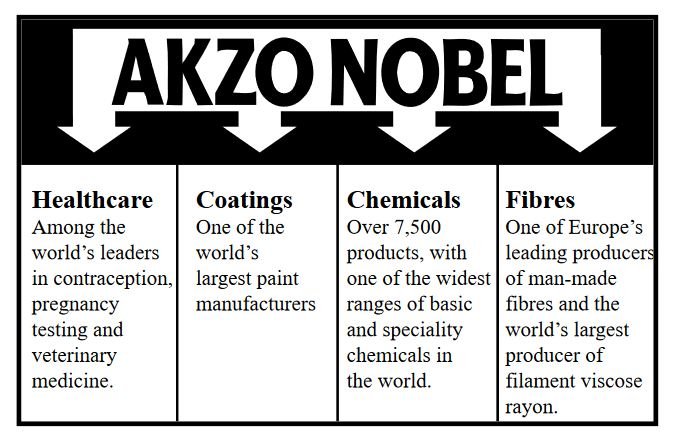
This case study focuses on how Akzo Nobel, an organisation with many separate business units, an extremely diverse range of products and a large operating area, is developing a common thread of relationships between its business units based on corporate branding that reflects the central values of the company.
Background to Akzo Nobel
Akzo Nobel, headquartered in Arnhem, the Netherlands, is a market-driven and technology-based company, serving customers throughout the world with healthcare products, coatings, chemicals and fibres. The company employs 70,000 people and has activities in more than 60 countries. The UK, with 34 major sites, has become one of the most important countries for the company worldwide in terms of marketplace, manufacturing and research. Just under 4,000 people create UK sales well in excess of £500 million a year.

Following the merger of Akzo and Nobel industries in 1994, the UK has become one of the Group’s most important markets and an important centre for manufacturing and research.
Creating the balance – the Akzo Nobel identity profile
Akzo Nobel has sought to create a balance between the whole business and the individual business units. This involved creating a strong central mission and purpose, based on corporate branding, coupled with a clear communication flow within the organisation. This complex balancing act is summed up in the Akzo Nobel identity profile:
“Akzo Nobel is a multicultural, multi-faceted company that has a unique ability to master diversity.The ability to maximise people’s entrepreneurial talents is the essential leadership quality that makes us a strong and dynamic company. We have a clear sense of direction and common interest with respect to corporate conduct and responsible business practices. Capitalising on the individual abilities of our people means managing the balance between ownership and partnership. We use our technological knowledge and skills to constantly improve the quality of our processes and products and thus the quality of life.”
Core purpose and values

Akzo Nobel recognises that much of its strength lies in its diversity and therefore it seeks to channel this diversity in a positive direction to enhance the corporate branding of the company. The core purpose of the organisation has been established as:
‘diversity as core competence.’
In practice, this means avoiding a centralised, hierarchical management structure in favour of a balance between freedom and structure, so that all participants are able to work in partnership, with ownership of the business. The core values of the company are:
- people focus
- opportunity driven
- customer/market orientation
- technology driven
- socially responsible.
The net effect is to create a core spirit for the organisation, based on fun, pride and respect.
Developing a ‘golden thread’

Akzo Nobel is seeking a ‘golden thread’ to enable the individual parts of the organisation to benefit from joint ownership of a shared vision. The need for a company-wide feeling – the basis for a strong corporate identity – is becoming increasingly important in a society based on increasing individualisation. It is not surprising that companies that have created such individuality (e.g. Sony and Virgin) are considered to be at the top of the league in their line of business. Some of the basic elements of Akzo Nobel’s Company (Mission) Statement are:
- We will focus our efforts on the success of our customers.
- We will provide competitive returns on our shareholders’ investments.
- We will create an attractive working environment for our employees.
- We will conduct our activities in a socially responsible manner.
The ambition of the company is:
“to be the first choice of customers, shareholders and employees, and to be a respected member of society.”
The prime symbol expressing this vision and ambition is the corporate brand. However, to ensure that Akzo Nobel employees are committed to the ‘golden thread,’ it has been necessary to enhance communication within the organisation – based on both top-down and bottom-up communication links.
Above all, Akzo Nobel believes in the importance of building on its existing diversity while at the same time trying to create a shared set of values. The image which the company likes to paint is that of a ‘salad bowl’ where each element adds its distinctive flavour to the benefit of the whole.
Looking to the future, Akzo Nobel is seeking to:
- establish collective responsibility for the corporate brand
- ensure everyone understands what the company stands for and that everyone ‘buys into’ the company’s interest
- avoid credibility gaps by remaining creative, flexible and responsive to the whole organisation.
The Akzo Nobel experience

Akzo Nobel serves both large industrial markets, such as the oil and aerospace industries and local consumer markets, such as chemists or DIY stores. Branding for such an organisation is therefore much more complex than, say, for Mcdonald’s, with its standardised operations and retailing outlets wholly focused on the consumer market. The vital question is how to create a corporate brand that effectively represents and supports diversity within the organisation.
Akzo Nobel is a diverse multicultural organisation for a number of reasons.
The company:
- operates in a wide range of geographical locations with different cultures and ways of doing things
- operates in a wide range of markets, each with its own pattern and way of doing things e.g. there is usually a major difference between business units which concentrate on production and technology and those with more of an emphasis on marketing
- has developed over the years from a range of mergers. This has involved bringing together a large number of business units each with its own history and culture.
Akzo Nobel has opted for a decentralised organisation that is business-unit driven, allowing individual units to focus directly on their specific markets. This then raises the question: ‘Why is a corporate identity or a corporate branding policy important?’ As far as the public is concerned, what have pharmaceuticals to do with coatings or fibres? Moreover, as chemical products are sold ‘business to business’, the final consumers are not generally aware of their existence.
A balancing act
On the one hand, it is necessary to encourage diversity and on the other, it is important to create a unifying quality corporate brand.

One current approach to branding is to create a number of categories as shown in the illustration, involving combinations of corporate and product branding.
- A single identity i.e. the corporate brand only. This applies to some industrial markets for chemicals, coatings and fibres, where the image of the corporate brand determines the reputation of the product and there is, therefore, no need for a specific product brand.
- A single identity plus product brand. This also applies to certain industrial markets for chemicals, coatings and fibres. In these markets, specific product brands are required because of high added value and/or the need for positioning in relation to other brands.
- An endorsed brand identity. This mainly applies to non-industrial markets for coatings where the product brand is the dominating factor and where some kind of endorsement with the corporate brand is applied.
- A pure branded identity. i.e. product brand identity only. This applies to pharmaceutical product lines and some activities of coatings, where no reference is made to the corporate brand in product presentation or packaging. However, the corporate brand is used for such areas as stationery, buildings etc. In practice, there is a ‘grey area’ or fifth category which lies somewhere between the four categories outlined above.

The challenge to business units

Akzo Nobel currently has 27 ‘autonomous’ business units each with its own distinctive culture. Increasingly, however, units are developing a stronger association with corporate branding. The organisation gains strength from the sum of its parts working together. The corporate brand is not an exclusive property of the Board of Management or corporate headquarters – it is shared by all parts of the organisation. The challenge facing the business units is to use the corporate brand to enhance their own business.
The importance of name and reputation
Following a survey of America’s most admired companies, Fortune magazine stated:
“You won’t find it on the balance sheet…if you ask the wizards on Wall Street how it figures into a company’s net worth, be prepared for some mighty blank stares. But more and more companies are now coming to realise that when managed correctly, a good name can be their most valuable and enduring asset.”
Strong companies with strong names are using well established corporate brands to help expand product lines, increase market share and move into new businesses and markets.
Managing the company’s reputation

Reputation management is primarily long term and affects all the company’s stakeholders – shareholders, customers, employees, suppliers, government regulators, the media and even competitors.
As a public company, Akzo Nobel is accountable to society for its activities. Its behaviour as a corporate citizen ultimately determines the continuance of its licence to operate.
Akzo Nobel has been developing competitive strengths in terms of its products and its communications, giving it a competitive edge. This is illustrated in the chart showing developments between 1950 and the year 2000.

The importance of extended leadership
Today’s managers need to be able to involve employees in the decision making process and encourage them to share responsibility for business activities. This shared ownership leads to shared commitment. Akzo Nobel wants managers who command and control, but who also influence employees to buy into a common purpose, a set of directions and responsible business practices.
Valuing a strong image
Corporations are publicly accountable for the value of their shares, financial strength, community behaviour, environmental responsibility, technological developments, etc. In other words, organisations today are judged by the quality of their corporate citizenship.
At the same time, an organisation like Akzo Nobel draws on diversity and actively seeks to exploit local knowledge and the different perspectives that people from diverse backgrounds bring to the overall benefit of the company.
The benefits of corporate branding
Corporate brands can be used to build confidence. The best way to do this is to ensure that individual products do not overshadow the company as a whole and its values. At the same time, the marketing of product brands should not be hampered by the corporate brand. Developing a close connection between the individual brands, the business units of the company and the overarching company through corporate branding creates a clear competitive advantage for Akzo Nobel. The corporate brand creates credibility for new products in terms of quality and service and of course, successful new products can also add to the status of the corporate brand.
The benefits of corporate branding include:
- enhancing awareness of the company
- creating a favourable impression of the company
- altering perceptions of the company.
It, therefore, makes sense to pass on the benefits of corporate branding to individual products.
Examples of corporate versus product branding
Akzo Nobel faces the challenge of creating a balance between corporate and product branding within its business units. The following examples set out to highlight some of the issues involved.
- Akzo Nobel Chemicals. Akzo Nobel Chemicals uses Akzo Nobel branding as a matter of course – it seems to be the right thing to do! This organisation feels that trying to sell without the Akzo Nobel name would dilute the value of its efforts – Akzo Nobel has a solid and reliable reputation to most people in the industry. Akzo Nobel Chemicals does put its own product names on its packaging but also relates those brands to Akzo Nobel. Every pack supplied, whether it be a 50gm sample or 13 tons in a bulk tanker, is identified by the product and the name of the company. Importantly, the Chemicals businesses take an international perspective so that wherever they sell – in the Far East, the United States or Europe – they use the same branding and product images. They believe this is the best way to create synergy within the organisation and that the corporate brand provides the assurance of high quality products.
- Akzo Nobel Decorative Coatings. The Decorative Coatings business unit is a clear contrast to the Chemicals business unit. The main emphasis in this business unit is on brands which enjoy consumer loyalty in their own right and are therefore valuable assets for Akzo Nobel. Crown, Sandtex, Sadolin, Magicote and Valspar are examples and are each recognised for specific product propositions which appeal to very different target audiences. Offering a portfolio of strong brands allows Akzo Nobel to appeal to specific consumers, capitalise on the heritage of those brands and strengthen its competitive advantage in the various product sectors. An Akzo Nobel corporate branding approach would not achieve such objectives. Research carried out by the Crown brand indicated that consumers have little or no experience with the Akzo Nobel name in the field of decorative coatings. The Akzo Nobel company name and address, however, is a legal requirement on the back of packs. The utilisation of brands also results in special and unique privileges such as the use of the Royal warrant. This cannot be used under the more general Akzo Nobel company name.
- Intervet. Intervet operates in a similar way to the Decorative Coatings business unit and typifies the way in which veterinary businesses operate. All packaging contains the Intervet logo. The Intervet Vaccine range has a distinct identity in itself and the brand name Nobivac appears on all small animal vaccine packaging. All communication with veterinary practices (i.e. customers) in the UK uses the Intervet logo only. This also applies to all advertising material, promotional items etc. All correspondence with suppliers, however, takes place on Akzo Nobel paper.
- Akzo Nobel Fibres. The approach employed by the Textile Fibres business unit, with their product Sympatex, depends on the audience. When the audience is the final consumer, the Sympatex brand is always used and appears with another brand e.g. M & S, Austin Reed, etc. It is felt here that the presence of the corporate logo would simply confuse the final consumer and therefore, it is not used. However, when the audience is the ‘trade’ i.e. retailers and other distributors, the Akzo Nobel name is used widely because it is felt that this enhances the credibility of the Sympatex product.
These examples present an interesting focus for discussion: to what extent should all the parts of a diverse organisation relate and interface with the corporate brand?
